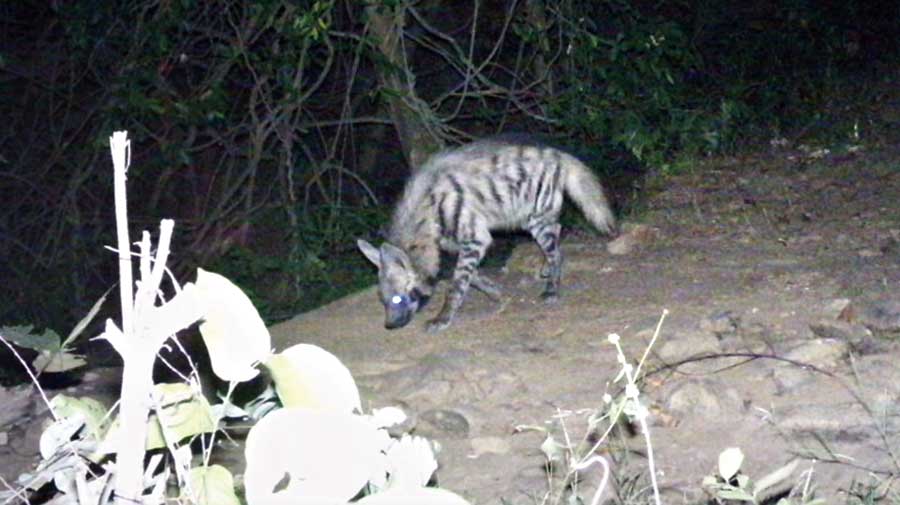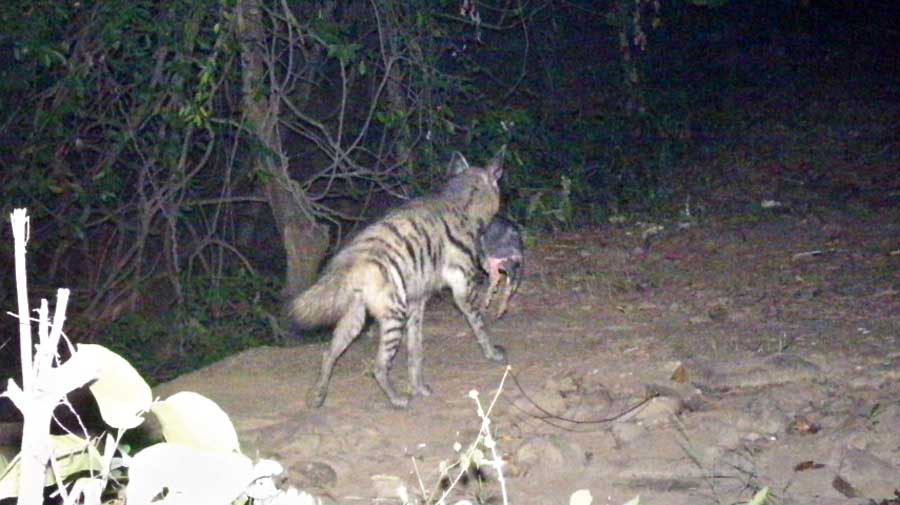A chance encounter between a wily scavenger with an unsavoury image and members of an NGO in Purulia has resulted in one of the first documentary evidence in many years of the animal’s presence in the region.
The animal in question was a striped hyena (Hyaena hyaena), spotted by the occupants of a car on the night of January 2 on a patch of grassland in Baghmundi, between Jhalda and Matha forests in Purulia, over 250km from Calcutta.

Picture of a striped hyena clicked by one of the camera traps laid by the ZSI as part of the study commissioned by the forest department
The members of the Human and Environment Alliance League (HEAL) in the car could not identify the animal at one go. “It is only after we got off the car and turned on a torchlight that the animal was identifiable,” said a member.
The animal crossed the road and turned back at the group before disappearing in the dark. During the encounter that lasted around five minutes, one of the members took some pictures of the animal on a Nikon D500. The use of the torchlight has lent a monochromatic character to the pictures, which the members shared with this newspaper.
The picture shows fluffy mane and dark lines along its light fur.
Animal Diversity Web (ADW), an online database of animal natural history, distribution, classification and conservation biology at the University of Michigan, describes the geographical range of striped hyenas as “Northern and Eastern Africa, the Middle East, India and Asia extending north to the Caucasus and Siberia”.
In India, they are said to be found in the semi-arid and dry fringe forests of Purulia, West Midnapore and Jhargram in Bengal, apart from the Deccan plateau, Rajasthan and Gujarat.
“Carcasses of other animals are their main food. As scavengers, they play a crucial role in the food chain and help prevent the spread of diseases by eating every bit of an animal,” said a researcher with the Wildlife Institute of India.
Hyenas have always been here in Bengal but have not been studied enough. “The extent of their distribution is largely anecdotal. Their population count is also unknown so far. There has been no scientific documentation of their presence,” said a forest official.
A study to assess the habitat and distribution of hyenas, wolves and some other animals, started two years ago by the Zoological Survey of India, has picked up pace after being stalled by the pandemic.
Striped hyenas are smaller and more solitary creatures than spotted hyenas of Africa.
“Spotted hyenas are famed scavengers and often dine on the leftovers of other predators. But these hardy beasts are also skilled hunters that will take down a wildebeest or an antelope,” says nationalgeographic.com.
In comparison, striped hyenas are much more docile, mostly spending the days in the burrows and coming out in the night, said the WII researcher.
Literature, traditional folklore and popular culture have not been kind to the hyena. In Disney’s popular animation film, The Lion King, hyenas are sidekicks of the villain, Scar.
“Several locals, especially people who steered cows and goats back to the villages from grazing in the evening, have seen hyenas. But many of them know hyenas as boro sheyal (large fox),” said Meghna Banerjee of HEAL, who was part of the group that chanced upon the animal and spoke to several residents of the area.
The lack of knowledge leads to man-animal conflict, she pointed out.

Picture of a striped hyena clicked by one of the camera traps laid by the ZSI as part of the study commissioned by the forest department
A hyena was allegedly killed, beheaded and chopped into pieces by some residents of a village in Purulia in July last year. Forest officials had suspected it to have been a retaliatory killing after the animal strayed into the village and lifted some livestock.
The ZSI study, commissioned by the state forest department, aims to stop such conflicts.
Camera traps laid in the forests of Purulia over the past couple of months have also captured pictures of multiple hyenas alongside other animals, said ZSI officials. “This is the first time that we have clicked pictures of hyenas in south Bengal,” said Kailash Chandra, the director of ZSI.
“The ZSI report will be the first scientific documentation of the habitat and distribution of animals like hyenas, wolves, golden jackals and leopard cats. The first step towards any conservation effort is a scientific documentation,” said V.K. Yadav, the chief wildlife warden of Bengal.











